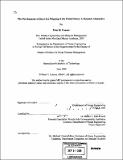| dc.contributor.advisor | Hauke L. Kite-Powell. | en_US |
| dc.contributor.author | Connor, Peter H. (Peter Harold) | en_US |
| dc.contributor.other | Massachusetts Institute of Technology. Dept. of Ocean Engineering. | en_US |
| dc.date.accessioned | 2006-07-13T15:23:30Z | |
| dc.date.available | 2006-07-13T15:23:30Z | |
| dc.date.copyright | 2004 | en_US |
| dc.date.issued | 2004 | en_US |
| dc.identifier.uri | http://hdl.handle.net/1721.1/33427 | |
| dc.description | Thesis (S.M.)--Massachusetts Institute of Technology, Dept. of Ocean Engineering, 2004. | en_US |
| dc.description | Includes bibliographical references (p. 122-128). | en_US |
| dc.description.abstract | Current projections show that U.S. international trade is expected to reach nearly two billion tons by 2020, approximately double today's level. With such a large forecasted growth in trade coming through the United States and growing problems associated with highway congestion, air pollution, and national security, building short sea shipping networks will be difficult, but possible, and potentially of great benefit to the nation. By bringing together shipping providers, customers, and with support from the federal government, short sea shipping can become a reality. This paper outlines the need for a change in our maritime transportation system. It takes a look at the current uses of short sea shipping in the United States as well as the system used in Europe. The technology associated with this concept is described and high-speed vessel design is investigated. Issues relating to the integration of short sea shipping are brought to light, including customer requirements, capital financing, and government policy. A computer-based simulation model calculates a total cost analysis for two modes of transporting goods, trucking and short sea shipping. The model is applied to a group of products of different size, weight, and value. | en_US |
| dc.description.abstract | (cont.) The quantitative results of the model show that in most cases, for lower value products, the savings in transportation costs from short sea shipping offset the increase in inventory costs. These results are then used to look at other commodities listed on the 2002 commodity flow survey to show the potential for short sea shipping use. | en_US |
| dc.description.statementofresponsibility | by Peter H. Connor. | en_US |
| dc.format.extent | 150 p. | en_US |
| dc.format.extent | 10050219 bytes | |
| dc.format.extent | 10056511 bytes | |
| dc.format.mimetype | application/pdf | |
| dc.format.mimetype | application/pdf | |
| dc.language.iso | eng | en_US |
| dc.publisher | Massachusetts Institute of Technology | en_US |
| dc.rights | M.I.T. theses are protected by copyright. They may be viewed from this source for any purpose, but reproduction or distribution in any format is prohibited without written permission. See provided URL for inquiries about permission. | en_US |
| dc.rights.uri | http://dspace.mit.edu/handle/1721.1/7582 | |
| dc.subject | Ocean Engineering. | en_US |
| dc.title | The development of short sea shipping in the United States : a dynamic alternative | en_US |
| dc.type | Thesis | en_US |
| dc.description.degree | S.M. | en_US |
| dc.contributor.department | Massachusetts Institute of Technology. Department of Ocean Engineering | |
| dc.identifier.oclc | 62867995 | en_US |
